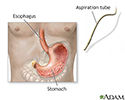Stomach acid test
Gastric acid secretion test
The stomach acid test is used to measure the amount of acid in the stomach. It also measures the level of acidity in stomach contents.
How the Test is Performed
The test is done after you have not eaten for a while so fluid is all that remains in the stomach. Stomach fluid is removed through a tube that is inserted into the stomach through the esophagus (food pipe).
A hormone called gastrin may be injected into your body. This is done to test the ability of the cells in the stomach to release acid. The stomach contents are then removed and analyzed.
Gastrin
The gastrin blood test measures the amount of the hormone gastrin in blood.
How to Prepare for the Test
You will be asked not to eat or drink for 4 to 6 hours before the test.
How the Test will Feel
You may have some discomfort or a gagging feeling as the tube is inserted.
Why the Test is Performed
Your health care provider may recommend this test for the following reasons:
- To check if anti-ulcer medicines are working
- To check if material is coming back up from the small intestine
-
To test for the cause of
ulcers
Ulcers
An ulcer is a crater-like sore on the skin or mucous membrane. Ulcers form when the top layers of skin or tissue have been removed. They can occur ...
 ImageRead Article Now Book Mark Article
ImageRead Article Now Book Mark Article
Normal Results
The normal volume of the stomach fluid is 20 to 100 mL and the pH is acidic (1.5 to 3.5). These numbers are converted to actual acid production in units of milliequivalents per hour in some cases.
Note: Normal value ranges may vary slightly depending on the lab doing the test. Talk to your provider about the meaning of your specific test results.
What Abnormal Results Mean
Abnornal results may indicate:
-
Increased levels of gastrin can cause increased release of acid and may lead to ulcers (
Zollinger-Ellison syndrome
).
Zollinger-Ellison syndrome
Zollinger-Ellison syndrome is a condition in which the body produces too much of the hormone gastrin. Most of the time, a small tumor (gastrinoma) i...
 ImageRead Article Now Book Mark Article
ImageRead Article Now Book Mark Article -
The presence of
bile
in the stomach indicates material is backing up from the small intestine (
duodenum
). This may be normal. It may also happen after part of the stomach is removed with surgery.
Bile
Bile is a fluid that is made and released by the liver and stored in the gallbladder. Bile helps with digestion. It breaks down fats into fatty acid...
 ImageRead Article Now Book Mark Article
ImageRead Article Now Book Mark ArticleDuodenum
The duodenum is the first part of the small intestine. It is located between the stomach and the middle part of the small intestine, or jejunum. Aft...
 ImageRead Article Now Book Mark Article
ImageRead Article Now Book Mark Article
Risks
There is a slight risk of the tube being placed through the windpipe and into the lungs instead of through the esophagus and into the stomach.
References
Scubert ML, Kaunitz JD. Gastric secretion. In: Feldman M, Friedman LS, Brandt LJ, eds. Sleisenger and Fordtran's Gastrointestinal and Liver Disease . 9th ed. Philadelphia, PA: Elsevier Saunders; 2010:chap 49.
-
Stomach acid test - illustration
The stomach acid test is a test to evaluate the capacity of the parietal cells in the stomach to secrete acid. The test is performed by aspirating fluid through a tube that is inserted down the esophagus to the stomach. This test may be used to test for the cause of ulcers, to detect duodenal regurgitation, to evaluate the cause of malabsorption, to assess the adequacy of anti-ulcer medications, and to evaluate secretion of gastrin.
Stomach acid test
illustration
-
Stomach acid test - illustration
The stomach acid test is a test to evaluate the capacity of the parietal cells in the stomach to secrete acid. The test is performed by aspirating fluid through a tube that is inserted down the esophagus to the stomach. This test may be used to test for the cause of ulcers, to detect duodenal regurgitation, to evaluate the cause of malabsorption, to assess the adequacy of anti-ulcer medications, and to evaluate secretion of gastrin.
Stomach acid test
illustration
-
Peptic ulcers
(In-Depth)
-
Gastroesophageal reflux disease and heartburn
(In-Depth)
-
Peptic ulcer
(Alt. Medicine)
-
Gastritis
(Alt. Medicine)
-
Gout
(In-Depth)
-
Kidney stones
(In-Depth)
Review Date: 11/20/2014
Reviewed By: Jenifer K. Lehrer, MD, Department of Gastroenterology, Frankford-Torresdale Hospital, Aria Health System, Philadelphia, PA. Review provided by VeriMed Healthcare Network. Also reviewed by David Zieve, MD, MHA, Isla Ogilvie, PhD, and the A.D.A.M. Editorial team.

